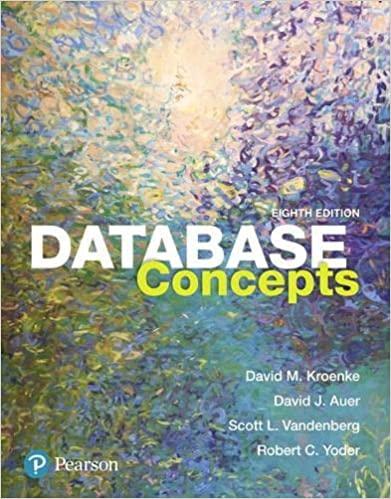Answered step by step
Verified Expert Solution
Question
1 Approved Answer
Business rules and requirements: Aotearoa Helpers is a nonprofit organization that provides aid to people after natural disasters. They mainly work with volunteers to provide
Business rules and requirements:
Aotearoa Helpers is a nonprofit organization that provides aid to people after natural
disasters. They mainly work with volunteers to provide their services. The organization
has been relying on Excel to manage its data. Recently, the Director of Operations
has realized that it has many data quality problems and asked you to help them design
a database to better manage its data.
Create an ERD using the following business rules and requirements. Please make
sure that the ERD follows good database design practices covered in Chapter
Individuals volunteer their time to carry out the tasks of the organisation. For
each volunteer, their name, address, and telephone number are tracked. Each
volunteer may be assigned to several tasks during the time that they are doing
volunteer work, and some tasks require many volunteers. It is possible for a
volunteer to be in the system without having been assigned a task yet. It is
possible to have tasks that no one has been assigned. When a volunteer is
assigned to a task, the system should track the start time and end time of that
assignment.
Some volunteers are part of volunteer organisations eg Volunteering New
Zealand, Volunteer Auckland while others are not part of any volunteer
organisations. A volunteer may be part of more than one volunteer organisation.
A volunteer organisation may have many members. We need to keep track of
which organisations these volunteers are members of and the start dates of
their membership. For each volunteer organisation, their name, address,
contact person and telephone number are tracked.
For each task, there is a task code, task description, task type, and task status.
For example, there may be a task with task code description of answer
the telephone, a type of recurring and status of ongoing There could be
another task with a code of description of prepare packages of
basic medical supplies, a type of packing and a status of open
For all tasks of type packing there is a packing list that specifies the contents
of the packages. There are many different packing lists to produce different
packages, such as basic medical packages, childcare packages, food
packages, etc. Each packing list has a packing list ID number, packing list
name, and a packing list description, which describes the items that ideally go into making that type of package. Every packing task is associated with only
one packing list. A packing list may not be associated with any tasks, or may
be associated with many tasks. Tasks that are not packing tasks are not
associated with any packing list.
Packing tasks result in the creation of packages. Each individual package of
supplies that is produced by the organisation is tracked. Each package is
assigned an ID number. The date the package was created, and the total weight
of the package are recorded. A given package is associated with only one task.
Some tasks eganswer the phones will not have produced any packages,
while other tasks egprepare packages of basic medical supplies will
be associated with many packages.
The packing list describes the ideal contents of each package, but it is not
always possible to include the ideal number of each item. Therefore, the actual
items included in each package should be tracked. A package can contain
many different items, and a given item can be used in many different packages.
Each item that the organisation provides has an item ID number, item
description, item value, and item quantity on hand stored in the system. Along
with tracking the actual items that are placed in each package, the quantity of
each item placed in the package must be tracked as well. For example, a
packing list may state that basic medical packages should include
bandages, bottles of iodine, and bottles of hydrogen peroxide. However,
because of the limited supply of items, a given package may include only
bandages, bottle of iodine, and no hydrogen peroxide. The fact that this
package includes bandages and iodine needs to be recorded along with the
quantity of each item included. It is possible for the organisation to have items
that have not been included in any package yet, but every package will contain
at least one item.
Choose three entities from the ERD that you develop, create three tables, and
enter five rows of data into the tables. One of the tables should have at least one
foreign key that is a primary key of one of the other two tables. Capture the
screenshots of the table structure and rows of meaningful data and put them in
the WORD document after the ERD. For instance, a volunteer name should not
be aaaaaaa Save the commands that you use to create tables and enter data
into the tables in a SQL script file.

Step by Step Solution
There are 3 Steps involved in it
Step: 1

Get Instant Access to Expert-Tailored Solutions
See step-by-step solutions with expert insights and AI powered tools for academic success
Step: 2

Step: 3

Ace Your Homework with AI
Get the answers you need in no time with our AI-driven, step-by-step assistance
Get Started


